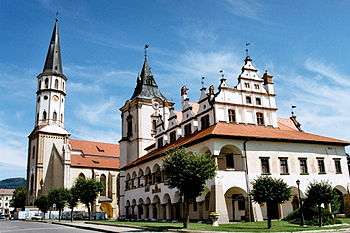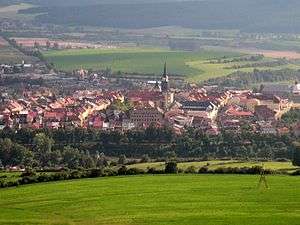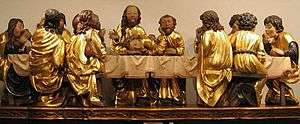Levoča
Levoča is a town in the Prešov Region of eastern Slovakia with a population of 14,700 (2016). The town has a historic centre with a well preserved town wall, a Renaissance church with the tallest wooden altar in the world, carved by Master Paul of Levoča, and many other Renaissance buildings. The town is known in German as Leutschau and in Hungarian as Löcse.

On 28 June 2009, Levoča was added by UNESCO to its World Heritage List.
Understand
History
Levoča is in the historical region of Spiš (formerly Szepes County), which was inhabited as early as the Stone Age. In the 11th century, this region was conquered and became part of the Kingdom of Hungary. It remained Hungarian until 1918. After the Mongol invasions of 1241/1242, the area was also settled by Germans. The town became the capital of the Association of Spiš Germans, with a form of self-rule within the Kingdom of Hungary. The oldest written reference to the city of Levoča dates back to 1249. In 1317, Levoča (at that time generally known by the German name of Leutschau) received the status of a royal town. In 1321 wide-ranging concessions were granted enticing merchants, craftsmen and mine-developers to settle in the town.
In the 15th century Levoča, on an intersection of trade routes between Poland and Hungary, became a rich centre of commerce. It exported iron, copper, furs, leather, corn, and wine. At the same time the town became an important cultural centre. The English humanist Leonard Cox taught around 1520 in a school in Levoča. The bookseller Brewer from Wittenberg transformed his bookstore in a prolific printing plant, that lasted for 150 years. Finally, one of the best-known medieval woodcarvers, Master Paul of Levoča, settled here. In this period of prosperity several churches were built and the town had a school, library, pharmacy, and physicians. Levoča was a center of the Protestant Reformation in Northern Hungary.
The town kept this cultural and economic status until the end of 16th century, in spite of two damaging fires: the first in 1550 and another in 1599. The town started to decline during the anti-Habsburg uprisings in the 17th century. In a lurid sequence of events in 1700, the mayor of the town was accidentally wounded by a local nobleman during a hunt, generating a series of revenge attacks, finally resulting in the murder of the mayor, Karol Kramler. The mayor's arm was then cut off, embalmed, and preserved in the town hall as a call to further revenge. This became the subject of a novel about the town, The Black City, by the writer Kálmán Mikszáth.
The economic importance of the town was further diminished in 1871 when the Košice–Bohumín Railway was built just 8 km to the south, bypassing Levoča and going through the nearby town of Igló, (today known by its Slovak name, Spišská Nová Ves). Later, in 1892, a spur line was built from Spišská Nová Ves railway station to Levoča. After the Treaty of Trianon and the dismantling of the Kingdom of Hungary, the city became part of the newly formed Czechoslovakia and its traditional Slovak name of Levoča was formally adopted. Later, during World War II, under the auspices of the First Slovak Republic, 981 local Jews were deported from the town to extermination camps.
On July 3, 1995 Levoča was visited by Pope John Paul II. He celebrated a mass for 650,000 celebrants at the traditional pilgrim site of Mariánska hora, a hill about 2 km north of Levoča with a spectacular view of the town.
Levoča today
Levoča remains a quiet, almost sleepy, town - unless there is a major event taking place, they roll the pavements up at about 20:30. The populations who created an intellectual centre over the past centuries - Hungarians, Germans and Jews - have largely vanished as a result of the political turmoil of the 20th century, and the town's inhabitants are now mostly Slovak, but with a substantial minority of Roma (gypsies). Despite Levoča's UNESCO World Heritage status, little has been done to capitalise on the town's enormous tourist potential, and whilst this is in one sense attractive to visitors, it doesn't much help the town's economy. Nevertheless, an interesting sign is the increasing number of foreigners who have bought and restored some of the historic buildings in the main square and its surrounding streets - these include Britons, Belgians, Israelis, Ukrainians and at least one New Zealander - so the town is gradually developing its reputation and a cosmopolitan population.
As a former 'royal city' Levoča is a member of the 'Pentapolitana' association which links it with Košice, Bardejov, Prešov, and Sabinov in developing education, culture and tourism.
Geography
Levoča lies at an altitude of 570 m (1,870 ft) above sea level and covers an area of 64.042 km² (24.7 sq mi). It is in the northern part of the Hornád Basin at the foothills of the Levoča Hills, at the stream Levočský potok, a tributary of the Hornád river. Poprad is 25 km (16 mi) to the west, Prešov 50 km (31 mi) to the east, Košice 90 km (56 mi) to the southeast and Bratislava 370 km (230 mi) to the southwest.
Get in

By air
The closest international airports to Levoča are at Poprad and Košice. Poprad and Kosice are approximately 25 and 75 minutes by road from Levoča respectively.
The nearby airport of Poprad is (as of 2015) served by scheduled flights to and from London, Gdansk and Warsaw.
By rail
The town has only a 🌍 small railway station of its own, with occasional trains to the nearby town of Spišská Nová Ves (about ten minutes by road).
Spišská Nová Ves is however served by regular trains from Bratislava (about 5 hours). Košice, from which there are regular buses to Levoča and trains to Spišská Nová Ves,(about 50 minutes) is also served by rail from Budapest (about 3.5 hours).
An excellent overnight train service runs to Poprad from Prague (and back) - this also transports passengers cars, saving a significant amount of driving. It is essential to book in advance, especially during the summer and winter tourist seasons.
By bus/road
Levoča is linked by regular buses to Poprad, Košice and Prešov.
There are bus services to Poprad from Krakow in Poland. Poprad is also served by international bus routes from Western Europe,including London and Brussels.
Levoča is close to the E50 European highway and can therefore be accessed by road via Poprad from the west or via Košice from the east.
Get around
To get to Levoca centre from the 🌍 bus station, either walk straight through the apartment blocks and estates behind the station, and take the second or third left to bring you out onto the main road. Alternatively, take a right turn at the station, walk around the corner and you can cross the road, and walk up through the town. This is the easier option for those with lots of baggage.
See
The historical centre, within the mediaeval fortifications, is quite small can be easily covered on foot.
- Renaissance old town and square..
- Fortifications and the two surviving gates:
- 🌍 Košice gate (at the main road entrance to the town).
- Polish gate (behind the 'Black Church' (see below)).
- 🌍 Sv. Jakob (St.James) Church. It contains the world's tallest wooden altar, a masterpiece of Master Paul of Levoca. The interior of Sv. Jakob is fascinating. Anyone who has an interest in architecture, art or even a passing interest in history will enjoy a visit, marveling at the quality of the restored carvings of Master Pavel's school, the 14th century murals, the stained glass windows that sparkle in the sunlight and the centuries old pews, worn and moulded by the previous inhabitants of Levoca. Visitors from England should take note of the statue of St.George slaying the dragon. For tourist purposes, tickets for access must be bought in the shop located opposite the main door of the Church. Guided tours are provided, and books, postcards etc. are available inside. After this you should visit Master Paul's House.
- Master Paul's House. In the main square opposite the Church, where nowadays his museum is located. This museum is a 'must-see' as it contains superb replicas of the painted wooden sculptures in the Church which it thus enables you to see at close range. They are exquisite and profoundly moving.
- 🌍 Renaissance town hall. The building of the Town Hall is attached to a Renaissance tower, which was built between 1656 - 1661 as a bell-tower. There are some exhibitss of the Spis Museum on the first floor of the Town Hall. Its Council Chamber is often used for presentations.
- Town theatre. The exquisite 18th-century theatre, the oldest building in Slovakia which has served continually as a theatre, is embedded in a larger modern structure, which also includes the town's Congress Hall. The Theatre and Hall offer a wide variety of performances, cultural events, and concerts, but also facilities for organizing congresses, seminars and various social events.
- Medieval cage of shame. This dates to the 16th century and it was used for punishing for minor delinquencies. Its original place was where the Protestant Church is situated now. Later, it belonged to the Probstner family and it was placed in their park, which was situated where the hospital is now. The Cage was given to the town by the Probstner family in 1933 and since then, it has been situated in front of the Town Hall.
- Neo-Classical Lutheran Church. The Lutheran church, in a cruciform layout and dating from the early nineteenth century, is somwewhat neglected, the congregation for the most part having been expelled in 1948 due to their ethnic German origin. These days, no more than seventy individuals frequent religious services. When the church is open for visits, a very friendly lady meets you at the main door, and leaflets describing the history of the church are available in Slovak, English, German, and Russian. Walking around the chapel, take note of the grand organ, a gift from the Lutheran community of Berlin from the early 1900s. There is also a memorial to the inhabitants of Levoca who fell in World War I. The upkeep of the building is a major strain on the community, so a donation, or the purchase of a few postcards on this otherwise free attraction are gratefully accepted.
- 🌍 Baroque Church of the Holy Spirit (near the Košice gate).
- Gothic Cloister. Located in the Minorites Monastery, in Klaštorská street, behind the main square. Adjoining is the so-called Black Church.
- The Large Provincial House. Between 1806−1826, an architect from the city of Eger, Anton Povolny, built a grandiose administration building, the Large Provincial House, as the seat of the town's administration. He adjusted its Classicistic style to Levoca's Renaissance character by emphasizing the horizontal lines.
- The Spis Museum (in the main square). Dedicated to ethnology and history of the Spis region. Some sculptures of Master Paul are also on display.
Outside the centre
- 🌍 Basilica of the Visitation of the Blessed Virgin Mary. Located above the town on the hill of Marianska hora, and offering spectacular views over the town and countryside. Pope JohnPaul II visited here in 1995 and conducted a service. The Bascilica can also be reached by road (turn right before entering the town by the Košice gate, and then right again).
- Jewish cemetery. This picturesque but rather dilapidated leftover of the town's history is due for a restoration.
- Zavada. This very quaint village, with spectacular views of the Tatra mountains and good skiing in winter, can be reached by road (turn right before entering the town by the Košice gate, and carry straight on past the village of Levočská Dolina).
Do
Levoča Mariánska púť, 1st Sunday of June. Large pilgrimage/gathering on the hill around Marianska Hora - up to 250,000 can turn up from across Eastern Europe. A good, friendly, carnival atmosphere.
Dni Majstra Pavla/Days of Master Paul. Occurs before the second weekend of August. Open air fairs (hand crafted souvenirs), folk dancing, open air cinema and a big town square laser show/disco to round off the weeks festivities.
Levočské babie leto/ Indian Summer in Levoča Classical musical festival taking place every year in October (2015: October 9th-12th). Musicians from all over Europe take part in the extravaganza.
Buy
Buy local crafts, especially during the 'Days of Master Paul' fair in August (see below). Particularly recommended; woven table and decorative cloths; carvings; shepherd's wooden musical pipes (fujárs).
Also look in the gallery attached to the art school in the main square for paintings by local artists.
Eat
- Restaurant Slovenka, Námestie Majstra Pavla 6/6 (Directly opposite from where the tourist coaches park on the main square), ☎ +421 948 319 717. With a name like Slovensko, obviously Slovak cuisine is what is offered here. The food is simple, yet tasty, and the staff are friendly. Their pirohy are delicious and for meat eaters, the pig feast defies description.
- Planeta Levoča Cafe & Restaurant. Modern cafe (also a bar) with a more non-Slovak leaning menu. The food is fine, well priced, the beer is faultless, the staff are welcoming, and they provide a selection of breakfast and vegetarian options too. Located at the end of the square opposite the Lutheran church, beside an internet cafe, it's worth a visit for a lunchtime snack, but does not serve food in the evenings, when it becomes solely a bar (see below).
- Vegetarian - The name says it all. A veggie enclave just off the main square, and there is a sign pointing it out. This place servers a mix of salads, Slovak versions of vegetarian dishes, mild curries, tofu dishes, soups and it is also alcohol free. Any vegan travelers could do a lot worse than to visit. However, it's only open 11AM-3PM.
- At the Three Apostles. An old style restaurant, opposite St, Jakob's Church. This place is very comfortable, the staff are accommodating, and the portions really hit the spot, especially if the day has been spent travelling. A mixture of Slovak, meat, fish dishes are served, and the vegetarian pancake is divine. They also have an excellent selection of wines - and try their extra strength gazdovce slivovic as an aperitif!
Many of the town's hotels also have good value restaurants (see 'Sleep' below).
Drink

- Cafet - This is a newish bars, the crowd is young,(it even has,in summer at east, its complement of young Goth and Death Metal types). It's a lovely looking bar, with a mix of antique and quirky seats; it's quite arty and literary, and is nice for a quiet read on a hot summer day, or a freezing winter day too for that matter. The only downside is the smoke level, and the toilets. There is also outdoor seating in summertime.
- Bar - This is beside Cafet, and is where the local working men drink. It's a no nonsense, drinking bar, a 'local' basically. The inside is not too easy on the eye, but the hardworking owner and staff are very friendly. It also has great outdoor seating in summer, which can be recommended. The toilets are not the best.
Sleep
Budget
- The town has many 'bed-and-breakfast' facilities in local houses; these can be inexpensive (maybe Euros 10) and many are very hospitable. Look for signs in the windows of the houses bordering the town square, especially in Klaštorská Street.
- A very nice, comfortable pension (about Euros 20/night) with an excellent good value restaurant attached is U Januša (at Klaštorská 22).
Mid-range
- Hotel Barbakan. Košická 15. Good value, just off the top of the main square. Rooms €25-78 (2013).
- Penzion Miva. Gustáva Hermana 10. Quiet and friendly, between the old square and thetown walls. Rooms €24-60 (2013)
- Hotel Arkada. Namestie Majstra Pavla 26. The rooms here are furnished in a more old fashioned style, and this is not a disparaging comment. The furnishing is quaint and older than would be expected in other cities and towns, but all rooms are comfortable, and are good value for money. The restauranthas a cheap and cheerful basement restaurant, with prompt and friendly service. All rooms are en-suite. Has Wifi. Rooms €27-63.(2013)
- Hotel U Leva. Namestie Majstra Pavla 24. This hotel, also listed as a hostel, is the most modern looking in the area. The large, comfortable suites, bedrooms and bathrooms are furnished in a practical but modern manner. Some of the rooms give a great view out onto the main square. There is satellite TV and the breakfast buffet is a great way to prepare for a day of sightseeing, although I have noticed that the buffet is better in summer than at other times of the ear. For people who have been backpacking and roughing it, this is a good hotel to recharge ones batteries in. But the restaurant doesn't seem to operate these days at lunch or dinner. Rooms: €29-99.(2013)
Splurge
- Hotel Stela. Namestie Majstra Pavla 55. This was one of the first hotels in Levoca to be renovated. All the suites are comfortable and some suites are downright luxurious, which obviously is reflected by the four star rating of the hotel, especially some of the beautifully vaulted ceiling rooms. WiFi is available in selected rooms, and in the main hall and the Renaissance gallery courtyard is lovely for al-fresco drinking and dining during the summer. There is a cozy bar and wine bar also. The staff are courteous and friendly too. Has Wifi. Rooms €39-79.(2013)
Go next
Other attractions of the Spiš region are nearby, including the national park Slovenský Raj, Spiš Castle, the Tatra mountains, Vysoke Tatry, and the towns of Kežmarok and Poprad.